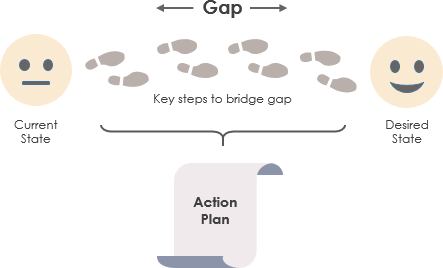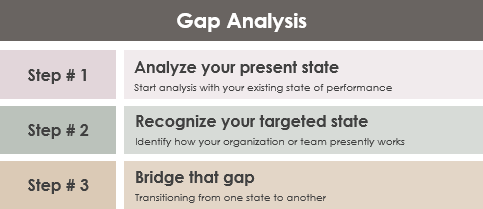Business process reengineering (also known as business process redesign, business transformation, or business process change management) is originally pioneered in the early 1990s. It is the analysis and redesign of core business processes to achieve the substantial improvements in its performance, productivity, and quality which means to change the way people perform the work in the improved process that accomplishes better business outcomes. The main goal of business process reengineering is to analyze workflows within and between enterprises to optimize the end-to-end process for achieving higher levels of efficiency, cut operational costs and become a world-class competitor.
BPR involves discovering how business processes currently operate, how to redesign these processes to eliminate the wasted or redundant effort and improve efficiency, and how to implement the process changes to gain competitiveness, typically called “as-is” and “to-be” analysis (also known as Gap Analysis).
Business models are developed as defining either the current state of the process, in which case the final product is called the “as is” snapshot model, or a concept of what the process should become, resulting in a “to be” model. By studying the difference between the current and target business state, known as the gap, the business analysts can determine if the existing business processes and information systems are sound and only need minor modifications, or if reengineering is required to correct problems or improve efficiency. Consequently, business process modeling and subsequent analysis can be used to fundamentally reshape the way an enterprise conducts its operations.

The As-Is process defines the current state of a business process in any given organization or structure. Generally speaking, the goal of analyzing the current state of a process is to find out which components could be improved. It is important to bear in mind that this As-Is analysis will only show you what can be improved, but not necessarily how. Mapping the As-Is process will only reveal how your business processes are working today.
Typically, a To-Be process is defined as the desired (or target) state of an organizational or business process. It is the ideal state of how you want your business processes to work, and mapping the To-Be processes will structurally clarify how you can get there. Thus, you will be able to see what changes are necessary for your business processes to reach their desired state.
A Gap Analysis can help an organization to understand where they want to be, the gap between where there are now and where they want to be, and hence, what steps (action plan) should be taken to close the gap.
Thus, to get from our current state to our desired state there will be several key steps we need to take to bridge the gap. From this, we will create an action plan outlining the exact actions we’ll take to achieve each step so we eventually close the gap.

Business Process Reengineering (BPR) is costly, sometimes even time-consuming and risky. I am here to introduce to you an Agile Tool for streamlining the entire BPR process management capabilities; empowering your team to design, plan and assess BPR in a single process canvas. In this way, you can ensure project data can be easily accessed and evolved throughout the entire BPR process and that the business process can be transformed seamlessly and error-free regardless of the scale of your operations. That means you can fully focus on process redesign, eliminate hours of unnecessary documentation and communication, and make more efficient use of your valuable time. The following screenshot illustrates the Agile BPR Tool Start Page:

Visual Paradigm offers fully automated Agile BPR software which provides a step-by-step guide on process reengineering, from planning through implementation and monitoring; significantly saving the time and cost and reduces risks of your projects. By the 7 simple steps, now you can achieve the most effective BPR with your team and keep everyone with the most up-to-date information on one single page.

Build an as-is model that helps you analyze the existing process. We provide a powerful BPMN tool that allows you to build the model and identify bottlenecks quickly and easily.

Quickly build a to-be process model for visualizing the desired business process. You may import the as-is model as a base and make changes, or to start from scratch.

Deepen the understanding of problems by analyzing the time and cost (e.g. Activity-Based Costing) of activities. Document the finding in a table that will become part of a process report.

Discover where an organization’s process, software and skills and more are falling short with the use of the gap analysis tool.
Visualize the gaps between as-is and to-be models with a colored map. By skimming through the map, readers can easily know where and what kind of improvements need to be made.

Detail the area that falls short. Outline the reasons and start to plan for improvements. The BPR tool helps you manage the gaps and solutions in an organized manner.

Build a work breakdown structure to structure the work needed to get from the current state to the desired state.
Identify a set of work packages that would lead to efficient and effective implementation re-designed process. Structure the result in a work breakdown structure.

Detail the work packages by completing the work package portfolio, which establishes the base used to estimate the duration and cost of the project, determine the required resources and schedule works.

List the implementation activities for progress tracking and monitoring. State the work packages associated, the responsible person and the target completion date.

Gain an overview of the activities needed to reengineer your business process. The best part? The roadmap is auto-generated – No manual editing is needed!

Define and maintain a list of KPI that suit your business and process. Assess the process’s performance on an on-going basis to ensure the effectiveness of process adoption.

Keep a list of the people who take part in the reengineering work. Link them with the various part of the process (e.g. as a responsible person of implementation activities).

Generate reports for as-is and to-be process models, gap analysis, KPI, performance assessment and more. Retrieve documents from a visual BPR cabinet.
